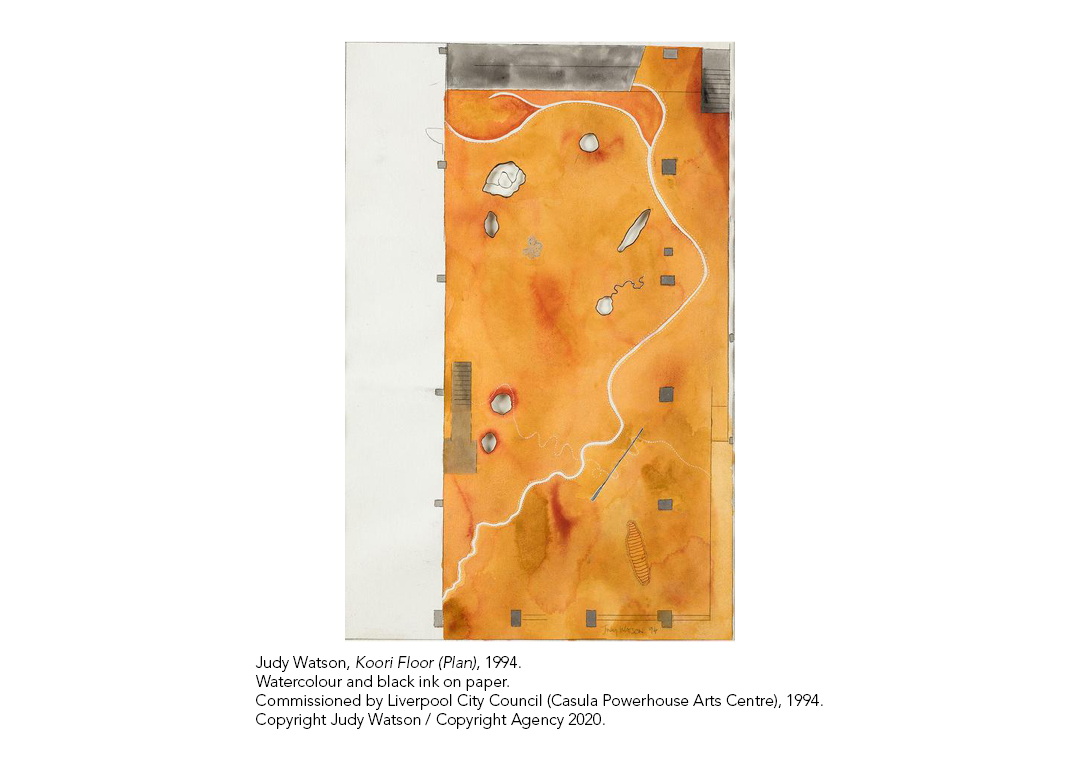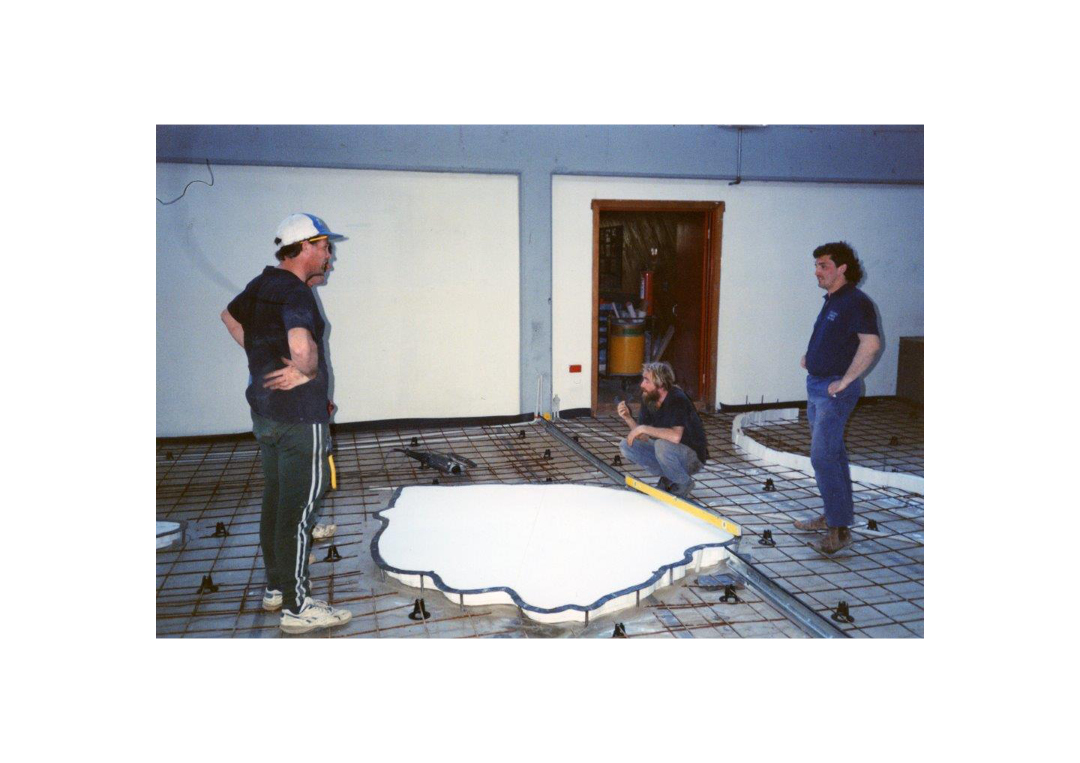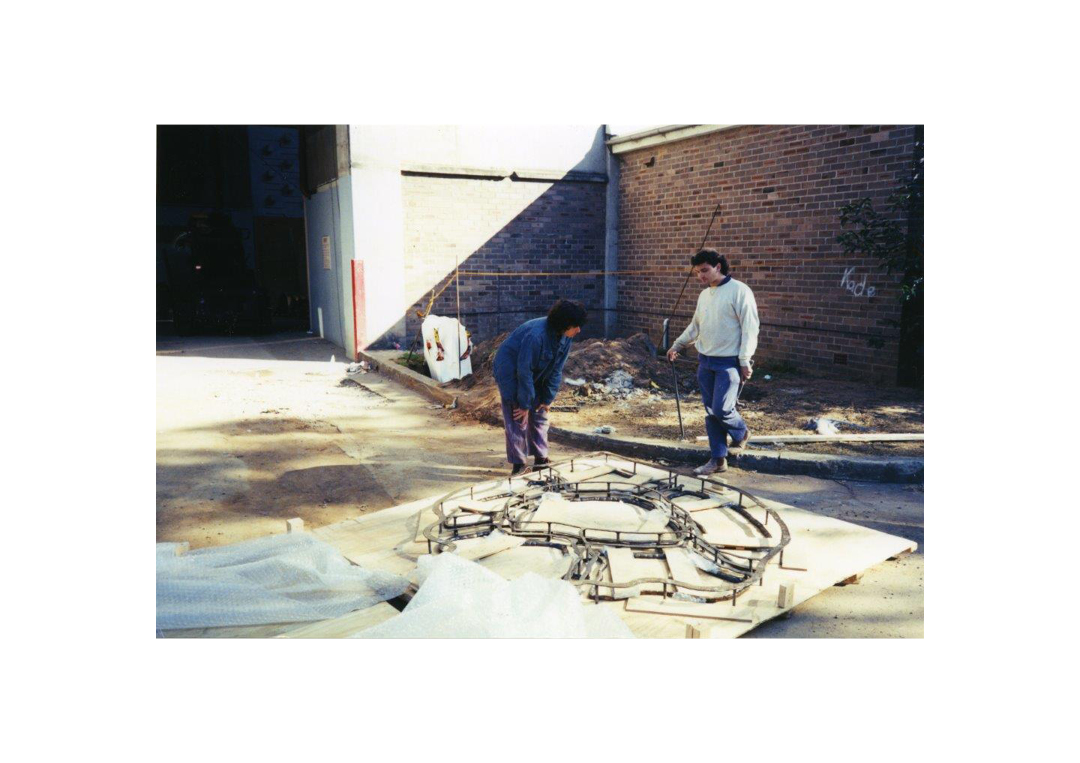THE KOORI FLOOR ARTWORK
In 2021 we completed a major restoration of our Koori Floor - an important and significant First Nations public artwork on our Turbine Hall floor by Brisbane based Waanyi artist Judy Watson. While keeping the original artwork in tact the restoration brought to life the vivid colours and original vision for the floor. It looks amazing and if you havn't seen the floor before there is no better time to see it in person.It is the first thing you see as you enter Casula Powerhouse and we are so pleased to be able to share it for generations to come.
Originally created in 1994 and invited by the then Director of the centre John Kirkman, Judy Watson worked on the piece with artists who have since gone on to great international acclaim including Gordon Hookey, Cheryl Robinson, Vivian Scott and Brook Andrew. It is an artwork that is now viewed as internationally significant and is a fundamental part of the heritage of Casula Powerhouse Liverpool. Our building and programs were built on Aboriginal land. Always was, always will be.
The Koori Floor covers the 600sq metres of the Turbine Hall of Casula Powerhouse Arts Centre and is best viewed and appreciated from the upper-level walkway in the Turbine Hall. It was designed to acknowledge the Aboriginal presence on the site that predates the siting of European settlement and the construction and operation of the power station.



Artwork Background
The Koori Floor public art project was conceived by Liverpool City Council Cultural Planner Susan Conroy in 1992. It was Susan's intention that the Casula Powerhouse Arts Centre be redeveloped around a series of public artworks built within the fabric of the building. Critically the Koori Floor was created by contemporary Aboriginal artists engaging with the aspirations, values and stories of Aboriginal people from Liverpool and across the region.
Importantly, the Koori Floor was to be the key artwork. Everything would flow from it. Conroy's intention was to create a monumental public artwork that symbolically, physically and figuratively stated that as you entered the Casula Powerhouse you would be 'walking lightly upon Aboriginal land'. The work was to be a statement of historic fact. The building and its programs were built on Aboriginal land. Always was, always will be. The work was intended to be permanent.
Judy Watson was assisted on this commission by Indigenous artists Cheryl Robinson, Gordon Hookey, Vivian Scott and Brook Andrew and Urban Artists along with a large team of trades and specialists. The project was supported by the Western Sydney Areas Assistance Scheme, the Federal Department of Employment, Education and Training and Liverpool Council.
To create the Koori Floor, Watson consulted with local community groups, conducted research in local land councils, museums and libraries, visited significant sites in the region, and workshopped ideas with Indigenous children and elders from the area to develop a design for the site. She conducted extensive research with the assistance of elders from the local Gandangarra and Tharawal Land Council to understand the geography and history of the local area and chose the river as the lifeline in her work.
It should also be noted that the work was conceived, designed and created within the political and aesthetic context of the early 1990s. Significant historical events include: the development of formal processes of Reconciliation, the Mabo Decision and the Native Title Act 1993 becoming law. The selection of Judy Watson as project artist was similarly significant, and was done so on the basis of her personal, political and aesthetic connection to Aboriginal Country, place, history, activism and community.
Recognising that Casula Powerhouse was designed as a meeting place for the people of all backgrounds in South Western Sydney, the Koori Floor was always designed to be a gathering and a shared space; one where histories might be buried but where histories which can be told, explored and made.
Artwork Features
The Koori Floor is made up of a painted and coated concrete floor with a series of rough holes in it. These holes have been lined with protective material painted with symbols and laid with items according to themes. (Including: small shells and bones collected from riverside middens, artefacts, stones and other pieces of significant indigenous importance.) The items have then been sealed with protective glass covers.
The substrate for the work is smooth concrete pigmented by hand in earthy and ochre colours which represent Indigenous mapping as a large- scale canvas or sand painting. A meandering concrete line across the floor represents the Georges River and is inlaid with stainless steel text of the names of the local language groups, the Gandangarra, Tharawal and Dharuk.
Inset into the floor are 7 glazed light ‘pools’ (‘industrial scars’ as Watson describes them) which appear as stepping-stones across the floor. Their ovoid shapes were inspired by the markings on scar trees on a local housing estate where canoes and shields had been cut from trees. The inlaid bronze outlines are shaped to resemble the way bark grows back around the scars on trees. Buried within the ‘pools’ are items representing archaeological artefacts including charcoal, river shells, fragments of quartz, seed pods, kangaroo rib bones, echidna quills and a small Aboriginal flag.
Replicas of shellfish hooks (bara) made from the metal of a turbine shell, impressions of dilly bags, fishing lines made from rolled tree bark and a bronze cast of a large fishing spear are incised or embedded in the floor, referencing the importance of the river for food gathering and survival. Hand stencils made from the imprints of local Koori children are marked on the floor. Charcoal from fire for cooking and ceremony and trade in ochre are also referenced. A group of circular silver swirls represent vibrating, spiralling, bubbling up life forces within the land alludes to the dynamism of the environment. This is seen too in the condensation beneath the glass-covered ‘pools’ and the natural change in the physical state of water, a reminder of the earth below and the life that it supports.
About the artist
Judy Watson is an internationally recognised Australian multi-media artist who works in print-making, painting, video and installation. Her work examines Indigenous Australian histories primarily connected to the past presence on their landscape.
Since the commission for the Koori Floor, Watson represented Australia at the Venice Biennale in 1997 and has taken public art commissions including Wurreka, Melbourne Museum, (1999); an installation in the Walama forecourt (2000) at the Sydney airport, for which artist Brook Andrew also contributed; Nggrrn-Gi – Land/ Law, Victorian County Court (2002), and heart/land/river at Brisbane Magistrate’s Court (2004).
In 2005, Watson was selected to produce two works, a glass ceiling and a glass wall facade, that were permanently installed in the Musee du Quai Branly, Paris, which opened in 2006. Recent works have included fire and water, Reconciliation Place, Canberra (2007); fresh water lens, Turbot Street overpass, Brisbane (2010); Tilt Train, vinyl wrap on train carriages, Queensland Rail (2011); She is currently completing the commission for the Eora monument bara in Farm Cove, for the City of Sydney.
In 2011, she exhibited Loveart: the love collection 2011 at Casula Powerhouse. She is currently advising on remedial works to the Koori Floor.
